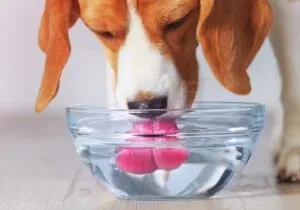https://www.whole-dog-journal.com/health/how-much-water-should-your-dog-drink/?utm_content=bufferc1e04&utm_medium=social&utm_source=facebook.com&utm_campaign=buffer&fbclid=IwAR3pq_dsz61RBzI3-tFfABczfjimuhpMFqKYA-NbrNvO-vqBlpPiK4z3yhk
Healthy dogs need to drink about an ounce per pound of their body weight daily – but many factors can affect their consumption.

How much water should a dog drink in a day? The simplest, most accurate answer to this question is, “However much he needs to maintain normal hydration.” The many variables affecting a dog’s daily water intake make it impossible to just pick a number. These variables include:
- The moisture content of his food. The moisture in fresh, canned, or semi-moist food meets some of the dog’s daily water requirements. Dogs fed these diets will drink less water.
- Puppies younger than 16 weeks old don’t have the ability fully concentrate their urine yet, so they drink more to make up for what they lose in dilute urine.
- Activity level. Exercising dogs pant for temperature regulation, which causes them to lose water through evaporation. Then they must drink more water to make up the deficit.
- Environmental temperature and humidity. The hotter and drier the environment, the more the dog pants and the more moisture he loses.
- Health status. Dogs with vomiting and diarrhea lose a lot of water, which can cause serious dehydration, fast. And dogs with metabolic disorders may urinate excessively. In each case, affected dogs need to drink more to keep up with the extraordinary losses.
Normal Daily Water Consumption
Although the above variables complicate things, here’s a guideline to a dog’s normal water consumption. Internal medicine specialists generally agree that normal water consumption for healthy adult dogs, resting in a temperature-controlled environment, is 50 to 80 milliliters of water per kilogram of the dog’s body weight per day (mls/kg/day). To convert this to ordinary household measures, there are 30 mls in an ounce, 8 ounces in a cup, and .45 kg in a pound of body weight.
If you look closely at the table, you will see that normal water consumption is about an ounce of water per pound per day. So easy to remember!
If your healthy adult dog seems to drink far less than this, never fear. As long as plenty of fresh water is available, a healthy dog will drink what he needs. There are highly effective mechanisms in the body that trigger thirst when water stores are depleted.
Having said that, be aware that dogs who are not feeling well can dehydrate in a hurry. If you notice the water bowl is not emptying at its usual rate, pay close attention to your dog’s attitude, appetite, and behavior. Dogs with fevers typically don’t feel well enough to drink what they need. Dehydration on top of fever can cause a snowball effect. Don’t hesitate to see your veterinarian if your dog seems to be feeling a bit under the weather.
Drinking Too Much?
We humans tend to be obsessed with a lack of hydration, but with dogs, it’s more important to recognize when they are drinking way more than normal amounts. This is called polydipsia, and it’s usually accompanied by polyuria (excessive urination).
There are many diseases associated with polydipsia/polyuria in dogs; the most common are kidney disease, diabetes, and Cushing’s syndrome. If your dog consistently drinks more than the amounts in the table, see your veterinarian as soon as possible.
Finally, be aware that dogs can suffer a variety of life-threatening conditions if they drink too much water in a relatively short time:
The behavioral issue of compulsive water drinking can impair the kidneys’ ability to concentrate urine, creating an unhealthy vicious cycle.
Dogs who swim or play for hours in water or who get obsessed with biting at lawn sprinklers can inadvertently ingest so much water that they suffer from low blood sodium levels (hyponatremia). This can cause brain swelling, and the dog may begin to stagger or become uncoordinated and exhibit lethargy, nausea, and excessive salivation. Left untreated, cerebral edema can be fatal.
And finally, large breed deep-chested dogs who are allowed to guzzle large quantities of water all at once may end up with gastric dilatation or “bloat.”
As you can see it’s important to be aware of how much water your dog is or isn’t drinking. It’s an important aspect of your dog’s general health monitoring.
| Dog’s Body Weight | Normal Water Consumption (oz/day) | Normal Water Consumption (cups/day) |
| 10 lb | 7.6 – 12.1 oz | 0.95 – 1.5 cups |
| 20 lb | 15.2 – 24.2 oz | 1.9 – 3 cups |
| 30 lb | 22.7 – 36.0 oz | 2.8 – 4.5 cups |
| 40 lb | 30.3 – 48.5 oz | 3.8 – 6.1 cups |
| 50 lb | 37.9 – 60.6 oz | 4.7 – 7.6 cups |
| 60 lb | 45.5 – 72.7 oz | 5.7 – 9 cups |
| 70 lb | 53.0 – 84.8 oz | 6.6 – 10.6 cups |
| 80 lb | 60.6 – 97.0 oz | 7.6 – 12.1 cups |
| 90 lb | 68.2 – 109.1 oz | 8.5 – 13.6 cups |
| 100 lb | 75.8 – 121.2 oz | 9.5 – 15.2 cups |
No comments:
Post a Comment